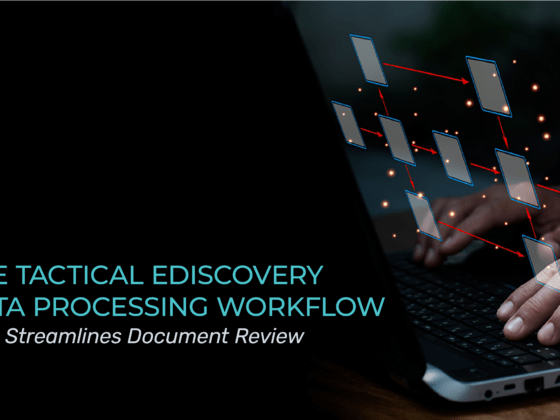Early Case Assessment in ediscovery allows legal teams to begin review with the least amount of data possible and a better understanding of what’s in that data.
Early Case Assessment might be the most important phase of any discovery battle. In the modern litigation landscape, the party that can analyze and digest digital evidence most effectively is most likely to prevail.
But like any legal technology practice area, there is a lot of disagreement over exactly what Early Case Assessment means in ediscovery and how to do it right. Here is what you need to know about ECA, why it is so important, and how it can help you win your next matter.
In Early Case Assessment, Knowledge Is Power
Why is Early Case Assessment (ECA) a big deal in ediscovery? Consider the fact that less than 1 percent of all civil cases filed in federal court go to trial. Since most matters will never get a hearing in a courtroom, the party that can quickly assess the evidence will be able to facilitate a settlement or resolution with confidence.
In short, ECA is the process of analyzing digital evidence and assessing the merits of a case to determine its viability. ECA also encompasses Early Data Assessment (EDA), although some practitioners consider the two to be distinct tactics. But for our purposes, EDA is the process of not only identifying potentially relevant electronically stored information, but the use of filtering or advanced analytics to fully grasp the scope of your discovery challenge.
Early Case Assessment and advanced data processing are important to producing parties as well as requesting parties. Under the amended Rule 26(b)(1), requesting parties can no longer demand discovery of virtually anything that could be helpful in litigation. Legal teams cannot provide vague, broad claims or objections and must make informed, detailed discovery requests – something that can only be obtained through ECA and EDA.
An Analytics-First Approach to Early Case Assessment in Ediscovery
In traditional, linear document review, legal teams would literally look at one document after another, ordered by date or keyword relevance. That approach has given way to an analytics-first workflow. That means legal teams can rely on software to understand case data through analysis and intelligent data culling.
Early Case Assessment software should give users detailed information about their data before it enters the review application, so that they can import and review the least amount of documents possible and be better prepared for document review. In its most basic application, Early Case Assessment may mean searching your available data collections to see if potentially relevant documents hit on selected keywords. If no documents are found, refine your search until better results are found.
Of course, the ECA process is iterative, meaning actions must be repeated until your team has a complete picture of the digital evidence. Use of Early Case Assessment tools in ediscovery can provide insight into the data set which you may not otherwise have and enables the ability to filter, search and perform different types of analysis prior to full processing.
Smarter ECA and EDA
However, ECA is not a shortcut and you should not rely on technology to do all of your research for you. To start, identify the key IT personnel who can help identify data sources. Document their input and selectively delete unnecessary data, but do it defensibly and document your choices. (ECA is the point at which you can win your case, but you can also destroy your chances with carelessness.)
Be sure to employ quality controls so that you do not corrupt documents, lose metadata, or destroy chain of custody. Data that is not readable or is corrupt should be eliminated from the review set and accounted for on output reports. Analytics and reporting tools can automate this process and help identify potentially relevant documents quickly, but legal teams need to be thoughtful about managing ECA.
Once you dig into the ECA process, software tools can generate reports that capture data volumes, custodian names, date ranges, email domains, keywords, and file types. This will hopefully tell you if there might be potentially responsive documents in the collection. If there is an unexpectedly high volume of data or complicated file types, you can better budget for the battle ahead. You can also begin to identify potentially privileged documents, which allows you to take appropriate measures to protect privilege in the review phase.
★ Your Early Case Assessment Checklist
- Identify key IT personnel who can help
- Selectively and defensively delete unnecessary data
- Document your choices
- Employ quality controls
- Use tools to better understand the data
A New Tool to Revolutionize ECA
ECA and EDA can help you cull or reduce data volumes before review begins, managing deadlines and expenses. Nextpoint is preparing to launch our new Data Mining app to help users manage exploding volumes of legal data and to give them all the information they need for an informed review.
The app will create detailed, visual reports on the content of your data, and you will be able to save searches and use them to create custom reports. It also includes Machine Learning tools to help with language detection, image recognition, transcription and translations, all of which can be exported for review.
In our experience, Early Case Assessment is not just an important phase of ediscovery, it is often when legal matters are won or lost.
Data Mining is officially here! Click here to learn more about this new groundbreaking technology.







